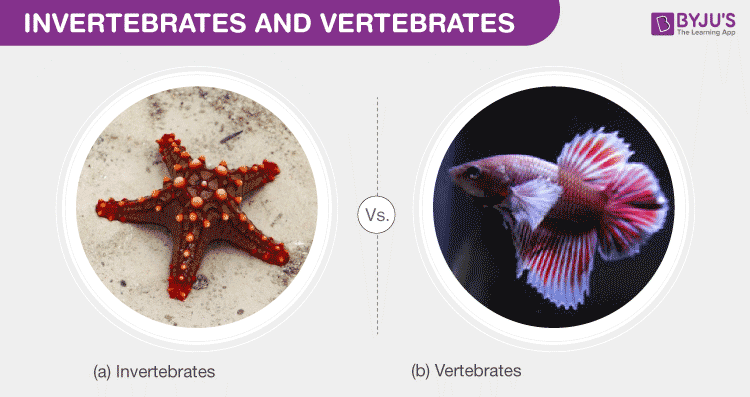Briefly explain its relations 1 Positive Feedback and oxytocin 2 Negative Feedback and insulin 3 Ovary and estrogen 4 Testis and testosterone 5 Neuron and nerve impulse. Vertebrates have two layers of the skin whereas invertebrates have a single layer of skin.

2 The Origin Of Life And Evolution Of Man Vertebrates And Invertebrates Classifying Animals Vertebrates
Major Differences between Vertebrates and Invertebrates.

. 10 rows This article will explain the concepts with the difference between invertebrates and. Invertebrates are animals without a skeletal system. Vertebrates are an endlessly fascinating group of animals because we are intimately familiar with them because we are them.
Animals that are characterized basically by the lack of backbones proper nervous systems and skeleton. Show examples of these groups and explain the characteristics that make one different from another. Invertebrates are animals that dont have a backbone.
A major difference between vertebrates and invertebrates is the symmetry that their bodies display. The animals that do not possess or develop the vertebral column that is usually grown from the notochord are termed invertebrates. Generally their body size is larger than invertebrates.
Sponges jellyfish worms and molluscs are all invertebrates. Animals can be classified into two main groups. Animals characterized by well-advanced and defined internal bones for different functions including a structured backbone.
Invertebrates do not have a backbone. Invertebrates lack a hepatic portal system while vertebrates have a hepatic portal system. Explain the relationship of the following pairs of terms.
They possess a backbone and an internal skeleton. Compare the structure and function of the following sensory structures in insects vs. What is the difference between vertebrates and invertebrates.
The main difference between Vertebrates and Invertebrates is that Vertebrates are the type of animals that have a spine surrounded by cartilage or bones and it comprises only 3 of animal species on the other hand Invertebrates are the type of animals that do not have any spine and it comprises of more than 95 of animal species. These animals have gone for an exoskeleton which has given them some advantages over the other invertebrate phyla. Therefore vertebrates always show bilateral symmetry but invertebrates show both bilateral and radial symmetry.
Invertebrates are sometimes mistakenly thought of as primitive because of their lack of developed organs. All vertebrates are bilaterally symmetric meaning that they display an external mirrored appearance to their left and right side however interior organs are not necessarily symmetric. The biggest most diverse invertebrate phylum is the Arthropoda.
The upcoming discussion will update you about the difference between vertebrates and invertebrates. After that come a variety of invertebrate phyla. For examplereptiles mammals birdshumanamphibian all fall under the category of vertebrates.
The most remarkable difference between Invertebrates and Vertebrates is the presence of backbone skull outer covering. 18 How many different types of invertebrates are there. Vertebrates are having the exoskeleton.
Other features like the Nervous system. The most numerous invertebrates are single celled animals. So vertebrates have bilateral symmetry.
Vertebrates possess at least in early life a stiff-supporting rod the notochord which is placed in the mid-dorsal line and extends from end to end. Of the planets estimated 1530 million. The main difference between vertebrates and invertebrates is that invertebrates like insects and flatworms do not have a backbone or a spinal column.
Whereas the vertebrates are classified as 30 phyla. The main difference between vertebrates and invertebrates is that vertebrates consist of a backbone whereas invertebrates do not consist of a backbone. The heart is present on the dorsal side of the body.
Their simple internal systems include respiratory systems such as gills or trachea and they often use an open circulatory system to pump their blood. It lies beneath the nerve cord but above the gut. Vertebrates reproduce sexually while invertebrates through asexual reproduction.
Animals can be classified as either vertebrates or invertebrates. Invertebrates are having an exoskeleton. Examples of vertebrates are mammals birds fishes etc.
Vertebrates are commonly called animals with backbones. On the contrary to vertebrates it can be defined that the invertebrates also known as non-chordates are animals that do not have a backbone or spinal column. Examples of vertebrates include humans birds and snakes.
The vertebrates can be classified into five groups mammals birds reptiles amphibians and fish. Vertebrates have a. Invertebrates are animals without a backbone.
They do not possess a backbone not an internal skeleton. Following are the key differences between Invertebrates and Vertebrates which may be helpful to some extent in understanding them. Vertebrates include fish amphibians reptiles birds and mammals.
Vertebrates are warm-blooded animals whereas invertebrates are cold-blooded animals. Some have soft bodies like worms slugs and jellyfish. The heart is present on the ventral side of the body.
Generally their body size is smaller than vertebrates. Invertebrates can display radial the organism only has a. Bilateral or radial symmetry.
Invertebrates are animals without spines while vertebrates have a spine. The primary distinction between vertebrates and invertebrates lies in the fact that vertebrates comprise of a backbone while invertebrates dont have an internal backbone.

Vertebrates And Invertebrates Vertebrates And Invertebrates Invertebrates Vertebrates

Differences Between Invertebrates And Vertebrates

Vertebrates Vs Invertebrates Ppt Guess Explain Vertebrates And Invertebrates Vertebrates Invertebrates

Two Classification Of Animals Vertebrates And Invertebrates Vertebrates And Invertebrates Animal Classification Life Science

0 Comments